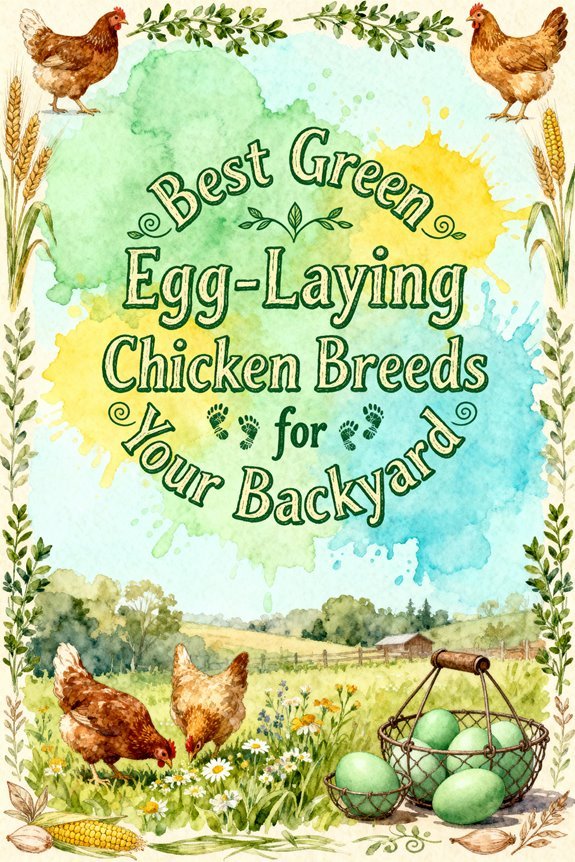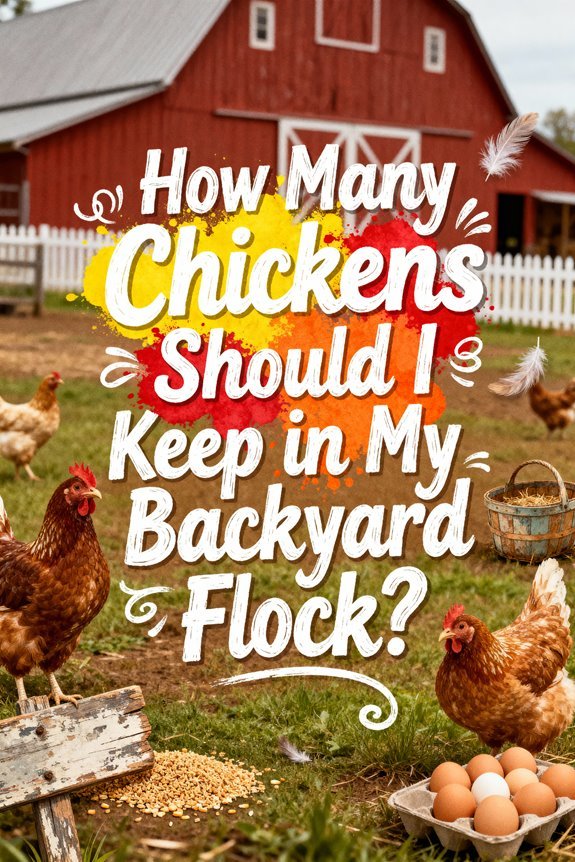Best Green Egg-Laying Chicken Breeds for Your Backyard
For reliable green egg production in your backyard flock, consider breeds like the Olive Egger, Green Queen, or Swedish Isbar. You’ll get 200-275 eggs annually from these specialized layers, which carry the blue egg gene combined with brown pigment overlays. These docile breeds thrive with 3-5 square feet of indoor space per bird and proper calcium-rich nutrition. Understanding their unique genetic makeup and care requirements will reveal their full laying potential.
Understanding Green Egg Genetics and Production
While many chicken enthusiasts dream of collecting colorful eggs from their flock, green eggs require specific genetic combinations to achieve. The secret lies in combining a blue eggshell base with brown pigment overlay. You’ll need chickens carrying the homozygous blue egg gene, which produces oocyanin throughout the shell, paired with breeds that deposit brown protoporphyrin pigments. Easter Egger chickens are popular mixed breeds known for laying these beautiful green eggs.
The Araucana breed originated in Chile and produces vibrant blue eggs that serve as an excellent base for green egg production. Understanding genetic inheritance is vital for consistent green egg production. For guaranteed results, breed a chicken carrying two copies of the blue allele with any brown egg layer. The resulting color variation depends on modifier genes that influence pigment intensity. You can expect your hens to produce over 250 green eggs annually during their peak laying years, making them valuable for both hobbyists and small-scale producers. Regular inspection of nesting areas for mite infestations is crucial since these parasites can significantly reduce egg production in otherwise healthy layers.
Top Green Egg-Laying Breeds for Beginners
When selecting green egg-laying chickens for beginners, five breeds consistently prove themselves as top performers in both egg production and temperament. The Olive Egger stands out with its docile nature and impressive output of 4-6 large eggs weekly, making it an ideal beginner choice. You’ll find the Green Queen‘s sociable personality and steady production of 250-275 eggs annually equally appealing. The Swedish Isbar offers reliability with its consistent laying pattern and adaptable nature. For cooler climates, consider the Favaucana, which maintains steady production even in winter. The Starlight Green Egger‘s friendly demeanor and prolific laying capacity of 280-300 eggs yearly rounds out your top beginner options. Each breed combines approachability with consistent egg production, essential qualities for novice chicken keepers. The Easter Egger’s calm and friendly nature makes them particularly popular among families with children. Their hybrid vigor gives them excellent disease resistance and adaptability to various climates. Like the Silver Spangled Hamburg, these green egg layers demonstrate remarkable consistency in their annual production rates.
Caring for Your Green Egg Layers
Successful green egg-laying breeds require specific care protocols to maintain their unique laying capabilities. Your green egg layers need a well-ventilated coop with one nesting box per 4-5 hens, lined with fresh bedding to protect their delicate eggs. Since breeds like Favaucana and Olive Eggers can be sensitive to environmental stress, you’ll need robust predator-proofing and climate control measures. Using hardware cloth mesh on all coop openings provides essential protection against raccoons and other determined predators.
Proper nutrition management is essential – feed a calcium-rich layer diet supplemented with fresh greens and oyster shells. Starting around 16 weeks old, transition pullets to a balanced layer feed to support optimal egg production. Implement a thorough disease prevention strategy by monitoring for common ailments like coccidiosis and mites, while providing dust baths for natural parasite control. Collect eggs daily and maintain 12-14 hours of light during winter months to guarantee consistent laying patterns. Keep stress levels low by avoiding overcrowding and maintaining clean, dry conditions. The Isbar chicken stands out as a particularly rewarding choice, producing moss green eggs throughout the year.
Comparing Egg Production Rates and Colors
Five notable green egg-laying breeds showcase distinct production rates and color variations. Green Queens lead in productivity, laying 250-275 eggs annually in shades from mint to deep olive. Easter Eggers follow with 200+ yearly eggs, displaying diverse colors from blue to green and occasional pinkish hues. Olive Eggers produce 200-250 eggs annually in darker olive-green tones, resulting from blue and brown egg-layer genetics. Isbar chickens maintain steady production at 200 eggs per year, characterized by their signature mint to mossy green shells. Cream Legbars round out the group with 180-200 eggs annually, though they’re primarily known for blue eggs. Each breed’s egg color variations remain consistent once established, making them reliable choices for specific shell color preferences in your flock. Easter Eggers are especially suitable for families due to their friendly and easygoing temperament.
Housing and Environment Requirements for Green Egg Breeds
Proper housing design plays a crucial role in maximizing your green egg layers’ productivity and well-being. Your coop design should provide 3-5 square feet of indoor space per bird, with secure hardware cloth protecting all openings from predators. Install elevated roosting perches and one nest box for every 4-5 hens to accommodate their natural behaviors. A spacious 40 square feet of total run area ensures optimal comfort for a flock of four hens.
For outdoor enrichment, create a run with 2-3 square feet per bird, incorporating vegetation for foraging and dust bathing areas. Shade structures are essential to protect your flock from summer heat while allowing natural behaviors. Make sure proper ventilation in your coop to manage humidity and prevent respiratory issues, while maintaining adequate insulation for winter comfort. Install nipple drinkers to provide clean, fresh water with minimal maintenance. Regular cleaning and bedding maintenance will keep your green egg layers healthy and productive year-round. Add clean nesting materials like straw or wood shavings to encourage proper egg-laying habits.





